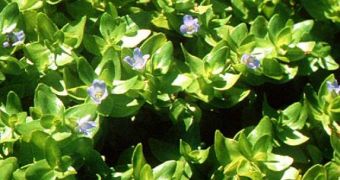One day we might actually have a decorative plant with gold running through its veins, glowing in our living-room, if a Taiwanese team of researchers that have created a living light source using gold nanoparticles, successfully continue their research.
The team led by Yen Hsun Su of the Research Center for Applied Sciences at the Academia Sinica in Taipei, put these particles in the water of Bacopa caroliniana, an aquatic plant used commonly in indoor aquaria and observed what happened next.
Wei-Min Zhang, a physicist at the National Cheng Kung University in Tainan and member of the team said that the key is the shape of the nanoparticles, which is similar to that of sea urchins, with narrow spines.
He said that these “spines can produce a stronger electromagnetic field,” which leads to brighter light.
In other words, the nanoparticles diffuse into the cells of the plant after a day or so, after which the researchers exposed the plant to ultraviolet rays.
UV rays energize the electrons within the nanoparticles, that start emitting a violet-blue light; this light makes the chlorophyll fluorescent and the light turns red.
This cohabitation between the plant and the gold particles lasted from two weeks to two months, New Scientist reports.
Haruki Niwa, a bio-organic chemistry expert at the University of Electro-Communications in Tokyo, Japan, is very excited about this work, and says that combining nanoparticles with live organisms is a very interesting research.
Still, he points out that “there are several hurdles these researchers will need to clear.
“Cost is one factor: they will need to make sure maintenance and other costs involved in setting up such a 'bio-LED' would make economic sense.”
More research on this topic is necessary because as Su said, for now, “the efficiency of our bio-LED is not high enough for a commercial device.”
The bio-LED principle should work on other plants as well, and could be used as decoration, or even as a source of faint light, say the researchers.
But before getting there, some of the existing problems need solving, like the constant UV light source necessary for the plant to glow.

 14 DAY TRIAL //
14 DAY TRIAL //